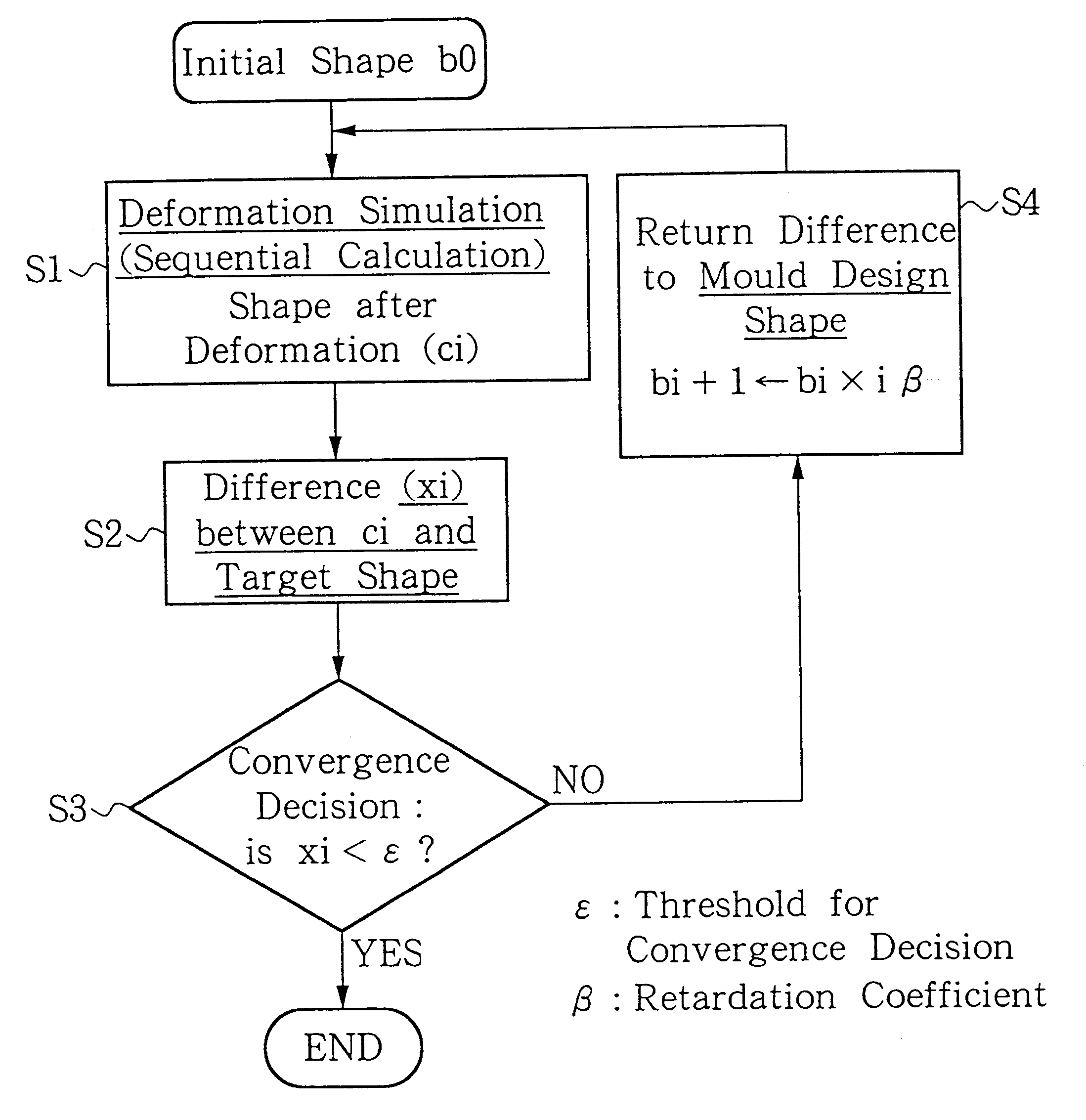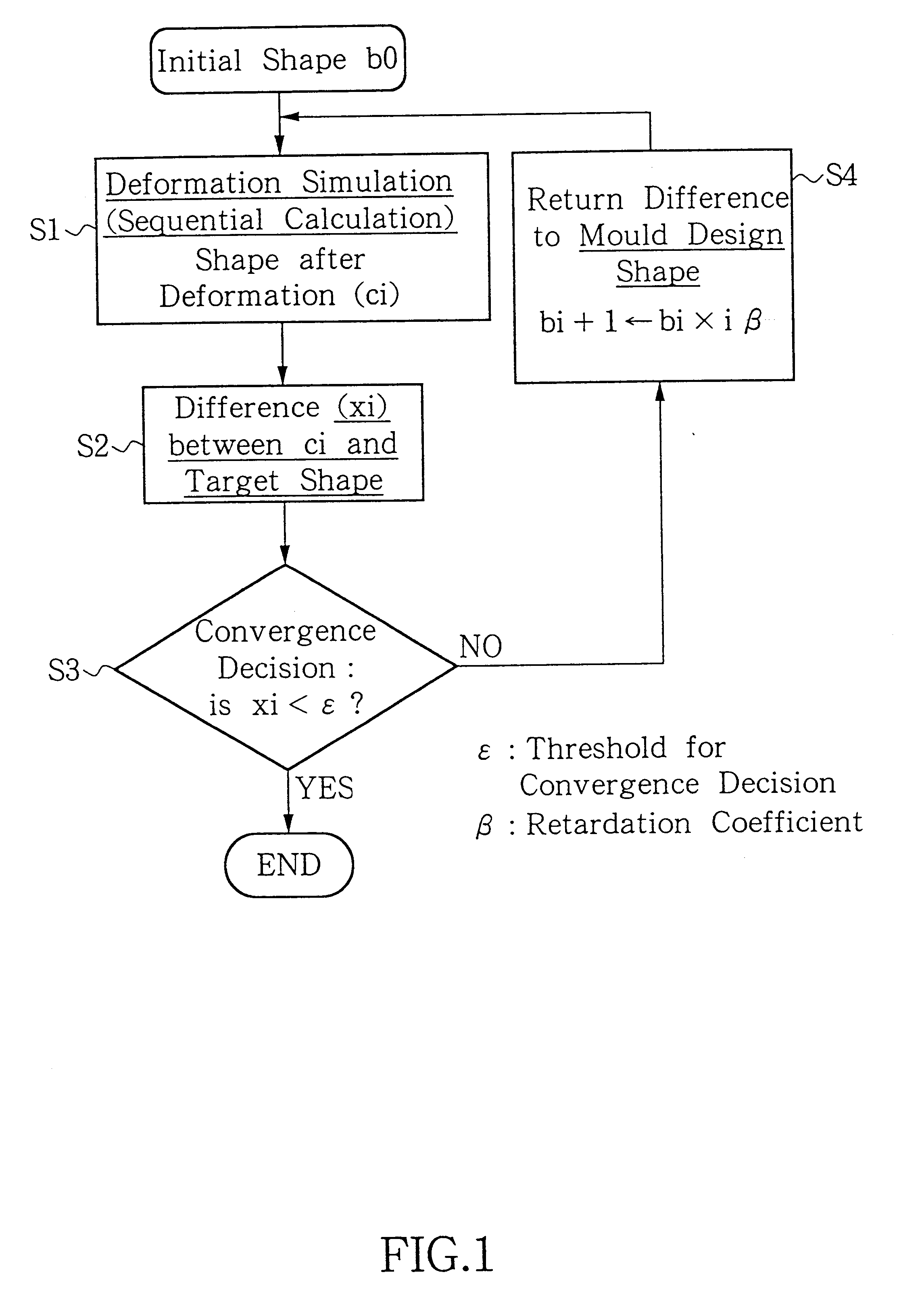Method for designing a metal mold
a metal mold and mold design technology, applied in the direction of moulding machines, instruments, moulding apparatus, etc., can solve the problems of large contracting of high-temperature molten plastic, nonlinear deformation, and inability to achieve targeted molding shapes,
- Summary
- Abstract
- Description
- Claims
- Application Information
AI Technical Summary
Benefits of technology
Problems solved by technology
Method used
Image
Examples
first embodiment
[First embodiment]
A first embodiment of this invention will be explained with reference to the bottle depicted in FIG. 2 as an example. If the taking out temperature is low, i.e. if there is very little deformation (and deformation is linear), then the metal mold shape that will give the target molding shape when the shrink deformation of the plastic that has been taken out from the metal mold is completed, can be obtained by multiplying the target molding shape by the reciprocal of the deformation ratio. However, this technique cannot be applied if the taking out temperature is high, i.e. if thermal shrink is large and nonlinear.
The inventors therefore repeatedly simulated the thermal deformation that occurs in the initial shape of a molding (this shape being determined by the design shape of the metal mold), and caused any difference between this simulation result and the target molding shape to be reflected in the metal mold design shape, and repeated this process until there was...
second embodiment
[Second embodiment]
A second embodiment of this invention will be explained with reference to FIG. 4, which is a flowchart of a metal mold design method according to this second embodiment. In this second embodiment, metal mold design also takes into account the deformation due to hydrostatic pressure resulting from the molded bottle having been filled with a liquid as its contents. The plastic is took out from the metal mold (S11) and undergoes thermal shrink type deformation (S12), whereby a molding is obtained (S13). As a result of this molding being filled with a liquid which constitutes its contents, it undergoes deformation due to hydrostatic pressure (S14), thereby assuming the shape of the end product (S15). In this second embodiment of the invention, this process is taken into consideration as well.
The flow of the design process proceeds in the reverse direction. That is to say, product design (S17) is carried out on the basis of a design concept (S16), and the molding is au...
third embodiment
[Third embodiment]
A third embodiment of this invention will be explained with reference to FIG. 5, which is a block diagram of a metal mold design apparatus according to this third embodiment. The metal mold design method disclosed in the first or second embodiment of this invention is performed by means of the metal mold design apparatus disclosed in this third embodiment. The initial shape of the metal mold (b0) is input in the form of three-dimensional information by means of keyboard 6. Deformation simulation arithmetic unit 1 calculates a simulation of the deformation that will occur after a molding equal in shape to this initial shape has been taken out from the metal mold. Difference arithmetic unit 2 calculates the difference between the calculated deformation and the target molding shape. Difference decision unit 3 compares this difference with a threshold. If this difference exceeds the threshold, initial shape change unit 4 applies a change to the initial shape on the bas...
PUM
| Property | Measurement | Unit |
|---|---|---|
| Fraction | aaaaa | aaaaa |
| Fraction | aaaaa | aaaaa |
| Fraction | aaaaa | aaaaa |
Abstract
Description
Claims
Application Information
 Login to View More
Login to View More - R&D
- Intellectual Property
- Life Sciences
- Materials
- Tech Scout
- Unparalleled Data Quality
- Higher Quality Content
- 60% Fewer Hallucinations
Browse by: Latest US Patents, China's latest patents, Technical Efficacy Thesaurus, Application Domain, Technology Topic, Popular Technical Reports.
© 2025 PatSnap. All rights reserved.Legal|Privacy policy|Modern Slavery Act Transparency Statement|Sitemap|About US| Contact US: help@patsnap.com



